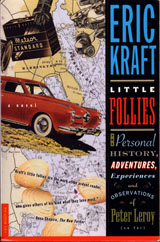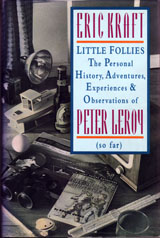

| Little Follies
The Static of the Spheres Chapter 20: “Peter Wants to Try Listening” |
by Eric
Kraft, as Peter
Leroy
|

YOU CAN READ THE FIRST HALF
YOU CAN ORDER THE
|
I opened the cellar door and peeked around it to make sure that Gumma had her eyes closed. She was holding her apron up over her eyes with both hands. The kitchen was full of the smell of turkey. I held the door open for Guppa, who was holding the radio in front of him in both hands. He set it on the kitchen table and plugged it in. “Okay,” I said, “you can look now.” My skin was tingling all over with pride in Guppa, with affection for the radio itself. Gumma looked at the shining radio with wide eyes, and she began clucking and exclaiming over it. Guppa beamed, and so did I. At last, Guppa said, “What do you say we put it to the test?” Gumma and I sat down at the table, silent and eager. Guppa switched the radio on. The tubes began to glow with tiny, intricate lines of orange light. Guppa put the earphones on and began twisting the dials. Gumma and I tried to read his expression. His smile slipped away, and he wrinkled his forehead and pursed his lips. He twisted the dials some more, and he tapped at a couple of the tubes. He wiggled the coil in its socket. Then he pulled the coil out and put in another. “How is it, Guppa?” I asked. He looked at me, but I could tell from his expression that with the earphones on he hadn’t made out what I had said. “How is it?” I asked again, in a much louder voice. Guppa flashed a smile and nodded. Gumma put her arm across my shoulder. Guppa began twisting the dials and tapping the tubes again, and he began to frown. He pulled the second coil out and put in a third. “Can I try?” I asked. I had to go to the bathroom, but I didn’t want to leave the scene of all the excitement, so I was squeezing my legs together and bouncing up and down. Guppa didn’t seem to hear me. Gumma tapped him on the shoulder, and he turned toward her with a start. “What? What’s the matter?” he asked in a loud voice. “Peter wants to try listening,” said Gumma, speaking with exaggerated precision. Guppa looked at me, and he seemed terribly tired. My expression was beyond my control. I was smiling so completely that I couldn’t speak when Guppa handed me the earphones. I slipped them on and fussed with them until they felt right or at least didn’t hurt my ears too much. I cupped my hands over them and held them to my ears. The sound seemed to come at once from within me, from the earphones, and from someplace far away. From a great distance came a sound like wind through willow trees, the rustle of the hanging branches of a weeping willow, the sweep of the branches along the ground. Winding through this was a deep and indecipherable murmur, like the voices of my parents and Gumma and Guppa when I had heard them talking together at night, years before, when I lay in my crib. And rising and falling through it all was a metallic sound, like the operation of a machine, very much like the scraping sound that Gumma’s toaster made. I looked at Guppa, who was looking at his shoes, and at Gumma, who was looking at me. Her lips were tight, and she was wringing her apron in her hands. “It’s just right, Guppa!” I said, and of course, with the earphones on and the static hissing in my ears I shouted it so loudly that Guppa looked up with a start and Gumma burst out laughing. I twiddled the dials, and the rushing hiss faded and the murmur became a howl, the metallic scraping began to echo, and an irregular ticking began somewhere far away. Gumma said, “Oh, Herb, I’m so proud of you,” and Guppa shrugged and smiled. Gumma got up and poured Guppa a glass of beer and then went back to making dinner, and Guppa went off to the living room. Neither of them asked to try the radio, and I didn’t offer. When my parents arrived I showed the radio to them but didn’t let them listen to it, and then we ate dinner, and after dinner I insisted on taking it to bed with me. |

|
||

Here are a couple of swell ideas from Eric Kraft's vivacious publicist, Candi Lee Manning: Tip the author.
Add yourself to our e-mailing list.
|
Little Follies is a work of fiction. The characters, incidents, dialogues, settings, and businesses portrayed in it are products of the author’s imagination and are not to be construed as real. Any resemblance to actual events or persons, living or dead, is entirely coincidental. All rights reserved. No part of this book may be reproduced or transmitted in any form or by any means, electronic or mechanical, including photocopying, recording, or by any information storage and retrieval system, without permission in writing from the author. “My Mother Takes a Tumble,” “Do Clams Bite?,” “Life on the Bolotomy,” “The Static of the Spheres,” “The Fox and the Clam,” “The Girl with the White Fur Muff,” “Take the Long Way Home,” and “Call Me Larry” were originally published in paperback by Apple-Wood Books. Little Follies was first published in hardcover by Crown Publishers, Inc., 201 East 50th Street, New York, New York 10022. Member of the Crown Publishing Group. YOU CAN ORDER THE
For information about publication rights outside the U. S. A., audio rights, serial rights, screen rights, and so on, e-mail the author’s imaginary agent, Alec “Nick” Rafter. The illustration at the top of the page is an adaptation of an illustration by Stewart Rouse that first appeared on the cover of the August 1931 issue of Modern Mechanics and Inventions. The boy at the controls of the aerocycle doesn’t particularly resemble Peter Leroy—except, perhaps, for the smile. |
|
||||||
| . | . |